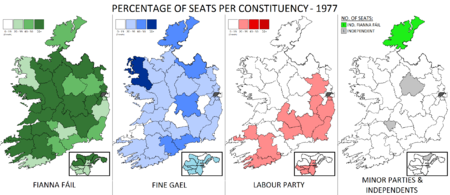Irish general election, 1977
|
|
|||||||||||||||||||||||||||||||||||||||||||||||||||||||||||||||
|
|||||||||||||||||||||||||||||||||||||||||||||||||||||||||||||||
|
|||||||||||||||||||||||||||||||||||||||||||||||||||||||||||||||
|
|
|||||||||||||||||||||||||||||||||||||||||||||||||||||||||||||||
| Percentage of seats gained by each of the three major parties, and number of seats gained by smaller parties and independents. | |||||||||||||||||||||||||||||||||||||||||||||||||||||||||||||||
|
|||||||||||||||||||||||||||||||||||||||||||||||||||||||||||||||
The Irish general election of 1977 was held on 16 June 1977 and is regarded as a pivotal point in twentieth-century Irish politics. The general election took place in 42 parliamentary constituencies throughout Ireland for 148 seats in the lower house of parliament, Dáil Éireann. The number of seats in the Dáil was increased by 4 from 144 to 148. The newly elected 148 members of the 21st Dáil assembled at Leinster House on 5 July when a new Fianna Fáil government replaced the incumbent Fine Gael–Labour Party coalition, with Jack Lynch becoming Taoiseach for the second time.
In spite of having faced some controversial issues during its term of office, the ruling Fine Gael–Labour Party coalition looked set to defy political history by winning an unprecedented second term. This belief was further augmented following the so-called "Tullymander" of parliamentary constituencies. This refers to the Minister for Local Government James Tully, and his scheme of redrawing every constituency in the country in an effort to maximise the vote for the coalition partners. For instance in Dublin there were thirteen three-seat constituencies. It was hoped that the coalition partners would win two of the seats, leaving Fianna Fáil with only one seat. A similar tactic was used in rural areas where the party was at its strongest.
...
Wikipedia



